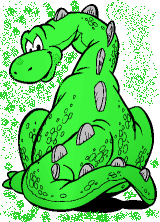|
'What is
this?'
A New Spin (cont'd)
1. The bigger they are ...
During the court case that followed the super-tanker Exxon Valdez environmental
disaster, it was revealed that the crew initiated a change-of-course maneuver
which would have taken some 45 minutes to complete (it was never
completed since the ship ran aground shortly thereafter). A kayak could
have turned around in a matter of seconds, once on a dangerous course,
but for a super-tanker it's just not possible.
Why can't a super-tanker turn on a dime like a kayak can? In
order to answer this question you may have to go back to your high school
 days. You may remember a physics experiment of a mass hanging on a spring
performing a 'Simple Harmonic Motion'. You may recall that when the mass
was increased it still bobbed up and down, but more slowly. It was
said that as the mass increases, the 'Physical-System' takes on a lower
'Natural-Frequency'.
days. You may remember a physics experiment of a mass hanging on a spring
performing a 'Simple Harmonic Motion'. You may recall that when the mass
was increased it still bobbed up and down, but more slowly. It was
said that as the mass increases, the 'Physical-System' takes on a lower
'Natural-Frequency'.
Nature clearly dictates that as size increases, the natural frequency
decreases,
and hence the system slows down. Therefore, one would expect a big
bell to have a low tone (a sound of a low frequency) i.e., having slow-changes;
and a small bell to have high tone (a sound of high-frequency) i.e., having
fast-changes.
 The next time you have a chance to peer into a grand-piano's entrails,
notice that the strings on the left side (corresponding to the low keys)
are long and thick, i.e., having high mass (big) while those on the right
(the high keys) are short and thin, i.e., having low mass (small).
The next time you have a chance to peer into a grand-piano's entrails,
notice that the strings on the left side (corresponding to the low keys)
are long and thick, i.e., having high mass (big) while those on the right
(the high keys) are short and thin, i.e., having low mass (small).
The same principle applies to animals. We intuitively associate a deep low-pitched
bark with a big dog and a high pitch as belonging to a yappie little fellow.
It follows that whether for objects or animals, the bigger they are, the
more sluggish they have to be.
2. Is there a limit to growth?
As animals grow in size there must be a point where they can no longer
sustain life since they become too slow to function. In order to test the
validity of this statement we need to conduct a little 'Thought-Experiment'.
Love this low-carb stuff
 Let's assume that this 100-ton plant-eater, which can be characterized
as not having to move much, is doing precisely that. Namely, it's just lying
there on its fat stomach amidst the lush vegetation which literally grows
into its mouth. All it has to do is just bite mouthfuls of the stuff to
feed itself.
Let's assume that this 100-ton plant-eater, which can be characterized
as not having to move much, is doing precisely that. Namely, it's just lying
there on its fat stomach amidst the lush vegetation which literally grows
into its mouth. All it has to do is just bite mouthfuls of the stuff to
feed itself.
Since the animal is cold blooded we can safely disregard any energy
it may require for its normal bodily function. The only energy it expends
is directed to its mouth muscles moving its enormous jaw up and down constantly
in the process of feeding itself. Every mouthful it takes, on the other
hand, contains exactly that amount of energy in vegetation so that the energy expended
is equal to the energy gained and the animal is doing fine-thankyou.
Now, let that animal grow to twice its size. In order to maintain its
proportion, it grows eight times in volume and weight (it has to grow twice
in length, twice in width... you get the picture). Since the jaws become
eight times their size and weight, their muscles require eight times the
energy in order to make them function. However, the volume of the
mouth also grows eight times and every mouthful contains now eight times
the amount of vegetation and energy, so there shouldn't be any problem, right? Wrong!
Having grown considerably larger, the animal becomes slower as we
have seen above. Although, its mouth can deliver the required energy in
each mouthful, it does that at a much lower-rate than the jaw muscles
require to constantly operate. Consequently, unless that animal can transform
itself to a government or to a major corporation (both of which can thrive
on a deficit) it's doomed!
Next: Not
convinced yet? What does rate have to do with it?
Contents
i. 'What is this?'
ii. --The short answer:
iii. --The long answer:
iv. For the impatient:
v. 'What is next then?'
1. The
bigger they are ...
2. Is
there a limit to growth?
3. Not
convinced yet? What does rate have to do with it?
4. Why
aren't any such big animals alive today?
5. What,
then, made it possible for them to take their place in the earth's
history?
6.
But aren't weight and size one and the same?
7. Are
we talking change in gravity, then?
8. What
is centrifugal force and how could it affect the weight?
9. What is it that
made earth's spin to slow down?
10. Where is the proof?
11. What is there
left to do?
Acknowledgment.
Comments.
Appendix: documented
evidence from independent sources.
|
